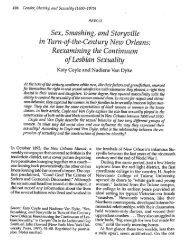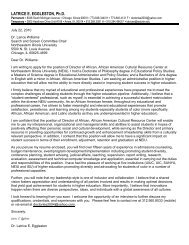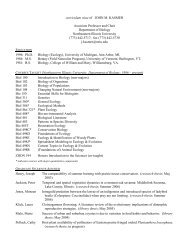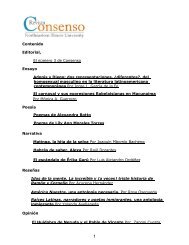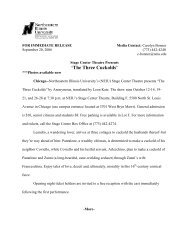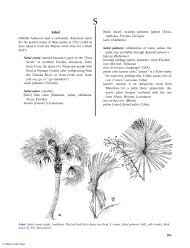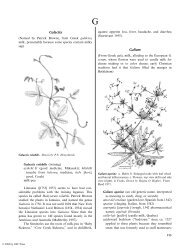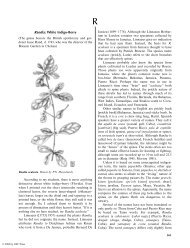Herba Cana - Northeastern Illinois University
Herba Cana - Northeastern Illinois University
Herba Cana - Northeastern Illinois University
You also want an ePaper? Increase the reach of your titles
YUMPU automatically turns print PDFs into web optimized ePapers that Google loves.
© 2004 by CRC Press<br />
534 Florida Ethnobotany<br />
We humans are incredibly arrogant and egocentric,<br />
and we tend to think that only big animals<br />
are important. Still, we can make fun of ourselves, and<br />
ants. There is a song High Hopes (1959) where,<br />
although everyone said it could not, an ant carries<br />
off a rubber-tree plant. So, never underestimate the<br />
importance of your neighbors.<br />
Polygonatum<br />
(From Greek polys, many, gonu, knees, alluding to the<br />
many joints of the rhizome)<br />
Polygonatum biflorum. From Britton and Brown 1896.<br />
frassinella (little ash, Italian 1551)<br />
Ladder to Heaven (John Parkinson wrote in 1640,<br />
‘‘Wee in English [call it] Salomon’s Seale most<br />
usually, but in some countries the peope call it<br />
Ladder to Heaven, according to the Latine scala<br />
coeli, which was anciently known to the<br />
Apotheccaries shoppes, from the forme of the<br />
stalke of leaves, one being set above another’’)<br />
poligonia (derived from the Greek polygonaton,<br />
Spanish 1557)<br />
Salomans seale (Gerarde [1597] 1975); Solomon’s<br />
seal (translated from Latin Sigillum solomonis;<br />
used in English by 1526 in the Grete <strong>Herba</strong>ll);<br />
Salomons segel (Dutch 1549); Salomonssiegel<br />
(modern German); sceau de Salomon (French<br />
1549); sigillo di Salome (modern Italian)<br />
scala caeli (ladder to heaven, Turner said this was<br />
English in 1548 even though it is Latin)<br />
Weiswurtz (white herb, German 1542)<br />
Polygonatum biflorum (two-flowered)<br />
seal-wort [sealwort]<br />
[great, King] Solomon’s seal; sceau de Salomon<br />
(Solomon’s seal, Quebec)<br />
utistugi’ (Cherokee)<br />
According to the OED (1971), people in the<br />
Middle Ages (A.D. 500 /ca. 1500) began calling European<br />
plants sigillium Solomonis (Solomon’s seal).<br />
That name was said to be based on an even older<br />
history, going back to the time of the biblical King<br />
Solomon. Greek physician Dioscorides (fl. A.D. 40 /80)<br />
called the plants polygonaton and wrote, ‘‘Spreading<br />
on the root helps cure wounds. Indeed, it also removes<br />
and aids facial blotches.’’ Roman doctor Galen (A.D.<br />
129 /?200) recorded, ‘‘The root of polygonatum is<br />
spread on wounds. It is with it that they clear<br />
birthmarks [moles] from the face.’’ In medieval times<br />
the plants were used to ‘‘seal’’ or ‘‘mend’’ wounds,<br />
sores, and especially bruises. Fuchs wrote in 1542,<br />
‘‘Women today still wash and color their faces with<br />
Solomon’s-seal.’’ (Meyer et al. 1999).<br />
Fuchs noted in 1542 that the pharmaceutical name<br />
for the plants in Germany was Sigillium solomonis<br />
(Meyer et al. 1999). Passage of time led to confusion<br />
and there arose three versions of why the plants were<br />
named after Solomon. One of the stories said that<br />
transverse sections of the rootstocks resembled a seal<br />
used by the biblical king. Another held that it was not<br />
the section but the leaf scars that looked like his seal.<br />
The third view held that it was because the root was<br />
good ‘‘to seal and close up green wounds’’ (OED<br />
1971).<br />
The Cherokee, Menomini, Meskwaki, Ojibwa, and<br />
Rappahannock used the American plants as medicine<br />
(King 1984, Moerman 1998). The Cherokee treated<br />
dysentery, breast diseases, carbuncles and other skin<br />
problems, leukorrhea, stomach problems, and lung<br />
diseases with the herbs (Hamel and Chiltoskey 1975).<br />
They also considered the root a mild tonic. The<br />
Menomini used the roots as an analgesic. The<br />
Menomini and Meskwaki put the root in an incense<br />
to revive unconscious people. The Ojibwa used the<br />
root as a physic and cough remedy. The Rappahannock<br />
treated cuts, bruises, and sores with the roots in a<br />
salve.<br />
The Cherokee used the dried roots to make flour<br />
for bread (Hamel and Chiltoskey 1975). Young stems<br />
were also eaten like asparagus. Yanovsky (1936) and<br />
Fernald et al. (1958) say that several northern<br />
tribes used them in the same ways. The Ojibwa burned<br />
the roots as incense before going to bed (Moerman<br />
1998).





